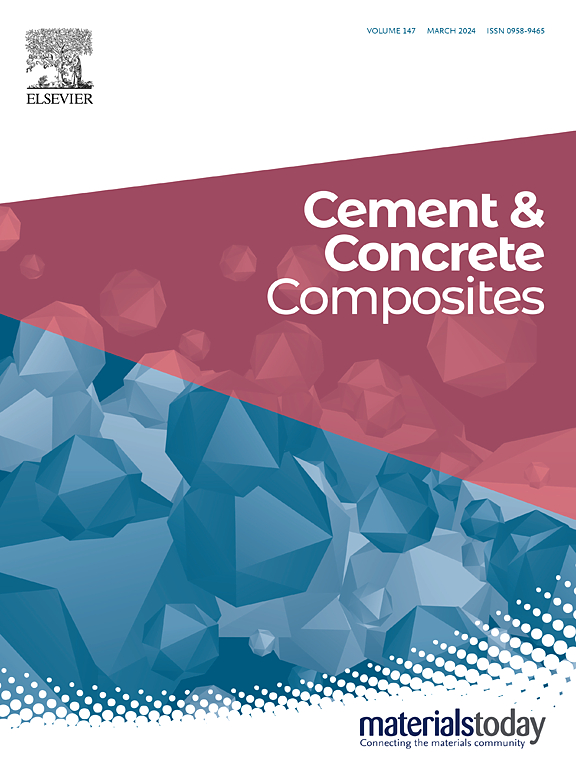Fire-and-corrosion resistance dual-functional EGC coatings: Design and performance characterization
IF 13.1
1区 工程技术
Q1 CONSTRUCTION & BUILDING TECHNOLOGY
引用次数: 0
Abstract
Fire and corrosion are two fatal threats to steel structures, while the current fireproof and anti-corrosion measures for steel structures are implemented separately, resulting in multiple interfaces and complex protection systems. This study, therefore, is dedicated to developing an integrated fire-and-corrosion resistance coating for steel structures. A novel coating made from engineered geopolymer composites (EGC) with ultra-high ductility is designed to simultaneously provide fire and corrosion protection for steel structures. The feasibility of EGC as a coating agent was rigorously evaluated through analyses of its workability, mechanical properties, thermal performance, chloride resistance, and microscopic characteristics. The results indicated that EGC effectively met both short- and long-term operational requirements for coatings. EGC demonstrated significantly superior specific strengths (strength-to-mass ratio), lower thermal conductivity, and lower chloride diffusion coefficient than those of conventional cement-based coatings. It owns steel-like tensile ductility (exceeding 9 %) and excellent crack-width control ability, promising superior deformation compatibility under large deformation and desirable thermal/corrosion resistance. Additionally, the energy consumption and carbon emission of EGC decreased by 43 % and 82 %, respectively, compared to traditional cement-based coatings. Capitalizing on the inherent fire resistance of geopolymer, alone with its high ductility, superior crack-control ability, exceptional thermal insulation and chloride resistance abilities, EGC emerges as a highly promising material for fire and corrosion protection applications, offering a sustainable and efficient solution for protective coatings in steel structures.
防火和耐腐蚀双功能EGC涂层:设计和性能表征
火灾和腐蚀是钢结构的两大致命威胁,而目前钢结构的防火和防腐措施是分开实施的,界面多,防护体系复杂。因此,本研究致力于开发一种用于钢结构的综合防火耐腐蚀涂层。一种由具有超高延展性的工程地聚合物复合材料(EGC)制成的新型涂层可以同时为钢结构提供防火和防腐保护。通过对EGC的可加工性、机械性能、热性能、耐氯性和微观特性的分析,严格评估了EGC作为涂层剂的可行性。结果表明,EGC有效地满足了涂料的短期和长期使用要求。与传统水泥基涂料相比,EGC具有显著的比强度(强度质量比)、更低的导热系数和更低的氯离子扩散系数。具有类似钢的拉伸延展性(超过9%)和优良的裂缝宽度控制能力,在大变形下具有优越的变形相容性和良好的耐热/耐腐蚀性能。此外,与传统水泥基涂料相比,EGC的能耗和碳排放分别降低了43%和82%。利用地聚合物固有的耐火性,凭借其高延展性,卓越的裂缝控制能力,卓越的隔热和耐氯化物能力,EGC成为一种非常有前途的防火和防腐材料,为钢结构保护涂层提供了可持续和高效的解决方案。
本文章由计算机程序翻译,如有差异,请以英文原文为准。
求助全文
约1分钟内获得全文
求助全文
来源期刊

Cement & concrete composites
工程技术-材料科学:复合
CiteScore
18.70
自引率
11.40%
发文量
459
审稿时长
65 days
期刊介绍:
Cement & concrete composites focuses on advancements in cement-concrete composite technology and the production, use, and performance of cement-based construction materials. It covers a wide range of materials, including fiber-reinforced composites, polymer composites, ferrocement, and those incorporating special aggregates or waste materials. Major themes include microstructure, material properties, testing, durability, mechanics, modeling, design, fabrication, and practical applications. The journal welcomes papers on structural behavior, field studies, repair and maintenance, serviceability, and sustainability. It aims to enhance understanding, provide a platform for unconventional materials, promote low-cost energy-saving materials, and bridge the gap between materials science, engineering, and construction. Special issues on emerging topics are also published to encourage collaboration between materials scientists, engineers, designers, and fabricators.
 求助内容:
求助内容: 应助结果提醒方式:
应助结果提醒方式:


